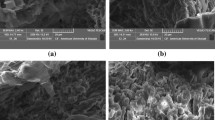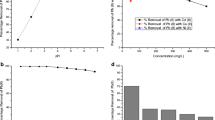Abstract
Heavy metals make up one of the most important pollutants in industrial wastewater. For wastewater, adsorbent materials developed from suitable biomass can be effective in removing the heavy metal ions. In this study, the powder of the bark of Platanus orientalis was used as a biosorbent to remove Cr(VI) and Ni from a nickel-chromium plating wastewater as a real sample for the first time. Two different adsorbents were used in analyzing the data: modified and non-modified bark. The extent of adsorption was dependent on the pH (in the range of 1.5, 3, 5, 7, and 9), the time of contact (in the range of 30, 60, 90, 120 min), and the adsorbent dosage (different doses of 0.5, 1, 1.5, 2 g L−1). The concentration of unabsorbed metals was measured by inductively coupled plasma-optical emission spectroscopy (ICP-OES, Model Thermo iCAP 6000). The maximum removal of Cr(VI) was obtained 89.6% for non-modified bark and 90.7% for modified bark both at pH of 5 in 2 g L−1 of adsorbent dosage in 300 min. While, the maximum Ni removal was obtained 74.5 and 56.5% for non-modified and modified bark, respectively, at pH 3 in 2 g L−1 adsorbent dosage in 90 min. Based on the results, Freundlich isotherm appears better fitted in adsorption with a better correlation coefficient (R2 = 0.998) than that of Langmuir model with a correlation coefficient of R2 = 0.996. The qmax for Ni1 and Ni2 were 126.58 and 285.714 mg g−1 and the qmax for Cr1 and Cr2 were 13.423 and 19.920 mg g−1, respectively. The FTIR studies indicated that S-O stretching group from sulfonate, surface O=H stretching, and also aliphatic C-H stretching are responsible for the adsorption. The SEM results obviously show the difference between the biomass surface before and after loading of ions. Ultimately, the present study concluded that P. orientalis could be a cheap and efficient biosorbent to adsorb and remove Cr(VI) and Ni from the plating wastewater; however, it seems more efficient for Cr(VI) with an average removal power of 90.15% than Ni with an average removal power of 65.75%.
















Similar content being viewed by others
References
Adewoye, L. T., Mustapha, S. I., Adeniyi, A. G., Tijani, J. O., Amoloye, M. A., & Ayinde, L. J. (2017). Optimization of nickel and chromium(III) removal from contaminated water using Sorghum bicolor. Nigerian Journal of Technology, 36(3), 960–972.
Ahalya, N., Kanamadi, R. D., & Ramachandra, T. V. (2008). Biosorption of chromium(VI) by Tamarindus indica pod shells. Journal of Environmental Science Research International, 1(2), 77–81.
Amiri, M. J., Fadaei, E., Baghvand, A., & Ezadkhasty, Z. (2014). Removal of heavy metals Cr(VI), Cd(II) and Ni(II) from aqueous solution by bioabsorbtion of Elaeagnus angustifolia. International Journal of Environmental Research, 8(2), 411–420.
Annadurai, G., Juang, R. S., & Lee, D. J. (2003). Adsorption of heavy metals from water using banana and orange peels. Water Science and Technology, 47(1), 185–190.
Aregawi, B. H., & Mengistie, A. A. (2013). Removal of Ni(II) from aquoues using leaf, bark and seed of Moringa stenopetala adsorbents. Bulletin of Chemical Society of Ethiopia, 27(1), 35–47.
Balarak, D., Mahdavi, y., Gharibi, F., & Sadeghi, S. (2014). Removal of hexavalent chromium from aqueous solution using canola biomass: isotherms and kinetics studies. Journal of Advance in Environmental Health Research, 2(4), 234–241.
Boruah, P., Sarma, A., & Bhattacharyya, K. G. (2015). Removal of Ni(II) ions from aqueous solution by using low cost biosorbent prepared from jackfruit (Artocarpus heterophyllus) leaf powder. Indian Journal of Chemistry Technology, 22, 322–327.
Boudaoud, A., Djedid, M., Benalia, M., Ad, C., Bouzar, N., & Elmsellem, H. (2017). Removal of nickel(II) and cadmium(II) ions from wastewater by palm fibers. Science Study Research., 18(4), 391–406.
Das, S. (2012). Biosorption of chromium and nickel by dried biomass of cyanobacterium Oscillatoria laete-virens. International Journal Environmental Sciences, 3(1), 341–352.
Dehghani, M. H., Sanaei, D., Ali, E., & Bhatnagar, A. (2016). Removal of chromium(VI) from aqueous solution using treated waste newspaper as a low-cost adsorbent: kinetic modeling and isotherm studies. Journal of Molecular Liquids, 215, 671–679.
Demirbas, E., Kobya, M., Oncel, S., & Sencan, S. (2002). Removal of Ni(II) from aqueous solution by adsorption onto hazelnut shell activated carbon: equilibrium studies. Bioresource Technology, 84, 291–293.
Gebrehawaria, G., Hussen, A., & Rao, V. M. (2015). Removal of hexavalent chromium from aqueous solutions using barks of Acacia albida and leaves of Euclea schimperi. International journal of Environmental Science and Technology, 12, 1569–1580.
Gular, Z., Dursun, A., & Ozkan, D. (2017). Volatile compounds in the leaf of plane tree (Platanus orientalis) with solid phase microextraction (SPME) technique. International Journal of Secondary Metabolite, 4(3), 167–176.
Gunatilake, S. K. (2015). Methods of removing heavy metals from industrial wastewater. Journal of Multidisciplinary Engineering Science Studies, 1(1), 12–18.
Hema, K. R., & Swamy, A. (2011). Studies on the removal of Ni(II) from aqueous solutions using powder of mosambi fruit peelings as a low cost sorbent. Chemical Science Journal, 9(3), 1389–1399.
Hosseini, S. V., Sobhanardakani, S., Tahergorabi, R., & Delfieh, P. (2013). Selected heavy metals analysis of Persian sturgeon's (Acipenser persicus) caviar from Southern Caspian Sea. Biological Trace Element Research, 154(3), 357–362.
Huang, L., Sun, Y., Yue, Q., Yue, Q., Li, L., & Gao, B. (2012). Adsorption of Cd(II) on lotus stalks-derived activated carbon: batch and column studies. Desalination and Water Treatment, 41(1-3):122–130.
Karthikeyan, T., Rajgopal, S., Miranda, L. (2005). Chromium(VI) adsorption from aqueous solution by sawdust activated carbon. Journal of Hazardous Materials, 124(1-3):192–199.
Khatoon, S., Anwar, J., Hassan, M. U., Farooq, M., Fatima, H. B., & Khalid, H. N. (2009). Removal of chromium(VI) by biosorption of eucalyptus bark. World Applied Science Journal, 6(12), 1638–1643.
Krishna, D., & Padma, S. (2013). Removal of chromium from aqueous solution by custard apple (Annona squamosa) peel powder as adsorbent. International Journal Applied Science Engineering., 11(2), 171–194.
Kumar, R., Obra, S., & Sharma, A. (2012). Biosorption of heavy metal ions by using modified waste tree bark material. International Journal Environmental Science, 3(1), 720–726.
Liu, J., Fan, H. P., Gong, G. Z., Xie, Q. (2013). Influence of surface modification by nitric acid on activated carbon’s adsorption of nickel ions. Materials Science Forum, 743-744:545–550.
Lopez-Nuñez, P. V., Aranda-García, E., Aranda-García, M. D. C., Morales-Barrera, L., & Cristiani-Urbina, E. (2014). Removal of hexavalent and total chromium from aqueous solution by plum (P. domestica L.) tree bark. Environmental Engineering Managment Journal, 13(8), 1927–1938.
Mamatha, M., Aravinda, H. B., Puttaiah, E. T., & Manjappa, S. (2013). Adsorbent from Pongamia pinnata tree bark for zinc adsorption. International Journal Science Engineering Technology, 2(1), 22–25.
Masih, J. (2015). Removal of chromium(VI) from aqueous solutions using natural adsorbents—FTIR studies. Journal of Chemical Pharmaceutical Research, 7(7), 145–151.
Muriuki, C. W., Mutwiwa, N. U., Home, P. G., & Kilonzo, F. N. (2014). Adsorption of chromium(VI) from aqueous solution by acacia tree (Acacia tortilis) charcoal. Journal of Sustainable Research Engineering, 1(3), 30–38.
Naiya, T. K., Singha, B., & Das, S. K. (2011). FTIR study for the Cr(VI) removal from aqueous solution using rice waste. In International Conference on Chemistry and Chemical Process (Vol. 10, pp. 114–119).
Overah, L.C. (2011). Biosorption of Cr from aqueous solution by the leaf biomass of Calotropis procera—‘Bom bom’,
Panda, H., Tiadi, N., Mohantry, M., & Mohantry, C. R. (2017). Studies on adsorption behavior of an industrial waste for removal of chromium from aqueous solution. South African Journal Chemical Engineering, 23, 132–138.
Panhekar, D. (2015). Activated tree bark as an adsorbent for heavy metal removal: study through isotherm analysis. International Journal of Chemical Physical. Sci., 4, 221–226.
Rani, S., Amala, F, .Vimala, J.R., Bhurana, T. (2012). Studies on the removal of nickel(II) using chemically activated Pouteria sapota seed and commercially available carbon. Pelagia Research Library, 3, 613–620.
Rezaei, H. (2016). Biosorbtion of chromium by Spirulina sp. Arabian Journal Chemistry., 9(6), 846–853.
Rozaini, C. A., Jain, K., Oo, C. W., Tan, K. W., Tan, L. S., Azraa, A., & Tong, K. S. (2010). Optimization of nickel and copper ions removal by modified mangrove barks. International Journal Chemical Engineering Applications, 1(1), 84–89.
Sen, A., Pereira, H., & Olivella, M. A. (2015). Heavy metals removal in aqueous environments using bark as a biosorbent. International Journal Environmental Science and Technology., 12, 391–404.
Shah, J., Kumar, S., Sharma, S., & Sharma, R. (2016). Removal of nickel from aqueous solution by using low cost adsorbents: a review. International Journal Scientific Engineering and Applied Science, 2(7), 48–73.
Shen, Z., Zhang, Y., McMillan, O., Jin, F., & Al-Tabbaa, A. (2017). Characteristics and mechanisms of nickel adsorption on biochars produced from wheat straw pellets and rice husk. Environmental Science Pollution Research., 24, 12809–12819.
Sobhanardakani, S., & Zandipak, R. (2015). 2,4-Dinitrophenylhydrazine functionalized sodium dodecyl sulfate-coated magnetite nanoparticles for effective removal of Cd(II) and Ni(II) ions from water samples.Environmental Monitoring and Assessment, 187(7), 412.
Sobhanardakani, S., & Zandipak, R. (2017). Synthesis and application of TiO2/SiO2/Fe3O4 nanoparticles as novel adsorbent for removal of Cd(II), Hg(II) and Ni(II) ions from water samples. Clean Technologies and Environmental Policy, 19(7), 1913–1925.
Sobhanardakani, S., Parvizimosaed, H., & Olyaie, E. (2013). Heavy metals removal from wastewaters using organic solid waste—rice husk. Environmental Science and Pollution Research, 20(8), 5265–5271.
Sobhanardakani, S., Hosseini, S. V., & Tayebi, L. (2018). Heavy metals contamination of canned fish and related health implications in Iran. Turkish Journal of Fisheries and Aquatic Sciences, 18(8), 951–957.
Sud, D., Mahajan, G., & Kaur, N. P. (2008). Agricultural waste material as potential adsorption for sequestering heavy metal ions from aqueous solutions, a review. Bioresource Technology., 99, 6017–6022.
Tripathi, A., & Ranjan, M. R. (2015). Heavy metal removal from wastewater using low cost adsorbents. Journal of Bioremediation & Biodegradation, 6(6), 100315.
Yaria, A. R., Shirzad, S. M., Hashemid, S., & Alizade, M. (2013). Removal of heavy metals from aqueous solutions by natural adsorbents (a review). Archives Hygiene Sciences, 2, 114–124.
Yasemin, B., & Zeki, T. (2007). Removal of heavy metals from aqueous solution by sawdust adsorption. Journal of Environmental Science., 19, 160–166.
Author information
Authors and Affiliations
Corresponding author
Additional information
Publisher’s note
Springer Nature remains neutral with regard to jurisdictional claims in published maps and institutional affiliations.
Rights and permissions
About this article
Cite this article
Akar, S., Lorestani, B., Sobhanardakani, S. et al. Surveying the efficiency of Platanus orientalis bark as biosorbent for Ni and Cr(VI) removal from plating wastewater as a real sample. Environ Monit Assess 191, 373 (2019). https://doi.org/10.1007/s10661-019-7479-z
Received:
Accepted:
Published:
DOI: https://doi.org/10.1007/s10661-019-7479-z




